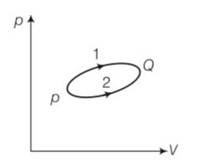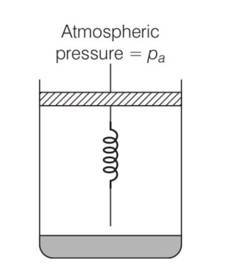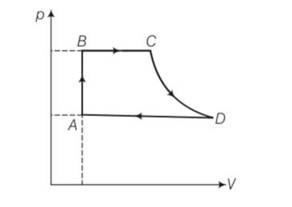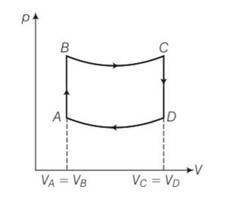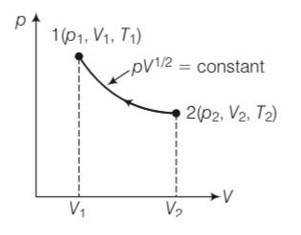Physics NCERT Exemplar Solutions Class 11th Chapter Twelve
Get insights from 37 questions on Physics NCERT Exemplar Solutions Class 11th Chapter Twelve, answered by students, alumni, and experts. You may also ask and answer any question you like about Physics NCERT Exemplar Solutions Class 11th Chapter Twelve
Follow Ask QuestionQuestions
Discussions
Active Users
Followers
New answer posted
5 months agoContributor-Level 10
This is a short answer type question as classified in NCERT Exemplar
For path1
Heat Q1= 1000J
Work done =W1
For path 2
Work done W2= W1-100
As change in internal energy is same
dU=Q1-W1=Q2-W2
1000-W1=Q2-W1+100
Q2= 1000-100= 900J
New answer posted
5 months agoContributor-Level 10
This is a short answer type question as classified in NCERT Exemplar
Yes this is possible when the entire heat supplied to the system is utilised in expansion.
So its working against the surroundings.
New answer posted
5 months agoContributor-Level 10
This is a long answer type question as classified in NCERT Exemplar
(a) Initially the piston is in equilibrium Pi=Pa
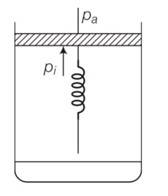
(b) On supplying heat , the gas expands from Vo to Vi
so increase in volume of the gas =Vi-Vo
as the piston is of unit cross sectional area hence extension in the spring
x=
force exerted by the spring on the piston= F= kx= K(Vi - Vo)
hence final pressure =Pf =Pa +kx
= Pa+K ( )
(c) From first law of thermodynamics
dQ=dU+dW
dU=Cv(T-To) = Cv(T-To)
T=
Work done by the gas =pdV+ increase in PE of the spring
= Pa(V1-Vo) + x2
dQ=dU+dW
= Cv(T-To)+Pa(V-Vo)+ x2
= Cv(T-To)+Pa(v-Vo)+1/2 ( )2
New answer posted
5 months agoContributor-Level 10
This is a long answer type question as classified in NCERT Exemplar
Slope of the curve = f(V) , where V is the volume
Slope of P = f(V) curve at ((Po, V0 )= f(Vo)
Slope of adiabatic at (Po, V0 )= k(-Y)Vo-1-Y =-YPo/Vo
Now heat absorbed in the process P= f(V)
dQ=dU+dW= nCvdT+pdV
pV=nRT
T= pV/nR
T=
nCv
After solving we get
=
Heat is absorbed where dQ/dV>0 when gas expands
Hence YPo+Vof'(Vo)>0 or f'(Vo)>(-Y )
New answer posted
5 months agoContributor-Level 10
This is a long answer type question as classified in NCERT Exemplar
(a) For process AB
Volume is constant , hence work done dW=0
dQ=dU+dW=dU+0=dU
= nCvdT= nCv(TB-TA)
=
=
Heat exchanged =
(b) For process BC , p =constant
dQ= dU+dW =
heat exchanged =
(c) For process CD , because CD is adiabatic , dQ= heat exchanged =0
(d) DA involves compression of gas from VD to VA at constant pressure PA
heat transferred as similar way as BC1
hence dQ = PA(VA-VD)
New answer posted
5 months agoContributor-Level 10
This is a long answer type question as classified in NCERT Exemplar
(a) For the process AB
dV=0 and dW=0
dQ=dU+dW=dU
dQ=dU= change in internal energy , so heat utilised is equal to change in internal energy.
Since p= in adiabatic temperature is directly proportional to pressure. So heat is supplied to the system in process AB.
(b) For the process CD volume is constant but the pressure decreases, hence temperature also decreases . so heat is also given to the surroundings.
(c) WAB= , WCD=
WBC=
= [pV]=
WDA=
B and C lies on adiabatic curve BC
PBVBY= PCVCY
PC = PB( )Y = PB( )Y= 2-YPB
Total work done by the engine in one cycle ABCD
New answer posted
5 months agoContributor-Level 10
This is a long answer type question as classified in NCERT Exemplar
pV1/2= constant
P=k/
Work done from 1 to 2
W=
from ideal equation = pV=nRT
T= pV/nR=
T=
T1= , T1=
=
U=
= RT1( )
=2p1V11/2( )
= 2p1V11/2(2 )
= 2p1V1( )= 2RT1( )
=
= RT1( )+ 2RT1( )
=
Taking an Exam? Selecting a College?
Get authentic answers from experts, students and alumni that you won't find anywhere else
Sign Up on ShikshaOn Shiksha, get access to
- 65k Colleges
- 1.2k Exams
- 679k Reviews
- 1800k Answers

